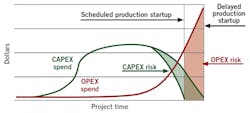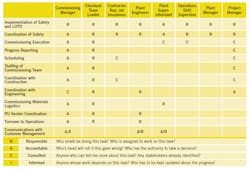Plant-critical shutdowns, turnarounds, and outages: How to deliver effective business results
For industrial plants to stay up and running smoothly, shutdowns, turnarounds, and outages (STOs) are a great opportunity to get some much-needed system maintenance and update work completed. A large capital expenditure (CapEx) project usually drives outages, which require a shutdown of either the entire plant or a process area. With capacity demand being high at many manufacturing sites, opportunities to perform projects like this are rare and well worth the time and effort.
At the top of the outage to-do list are substation maintenance, instrument calibration, and internal equipment cleaning. If it’s a CapEx outage, the engineering team typically leads the effort to get the project implemented and started up on time. The maintenance and operations teams usually have their own large list of tasks they would like to complete at the same time.
Of course, all this work is in addition to the staffing demands required to support the CapEx project. For plant personnel, STOs can be one of the most stressful times, especially when resource bandwidth is an issue. Everyone in the plant should have a vested interest in the project and take advantage of the opportunity to maintain or upgrade process control equipment as it leads to improved processes and operational efficiency.
Long before the STO work begins, the following best practices will help ensure effective operational results.
1. Define and communicate the project goal
To meet the goals and objectives of all internal personnel, the STO project team should plan early and gather input from key personnel to ensure company targets are met. Having a vision or clear understanding of the big picture helps set the stage to prepare and align the entire team. What is the company hoping to achieve, and what is the reason for the STO?
- Read "7 steps to STO success"
Projects are usually done for a reason, and people should understand what their role is to reach the company goal. Typical projects may include a major upgrade to improve safety or product quality; to introduce a new product to market; or to increase performance, which could be more throughput or minimization of loss. STOs may provide a return on investment (ROI) for the company to realize operating expense savings.
2. Understand the risks
Understanding the risks involved with the project is critical. Before the STO begins, key stakeholders should consider the impact to the company if the STO is not successful (see Figure 1). Typical risks include:
- Elevated potential for accidents or injury during non-routine operations
- Delays in production, such as a missed product launch that may already have sales commitments
- Additional operating expenses (OpEx) for missed target dates
- Additional capital expenses due to delays
- Missed revenue.
3. Define the key performance indicators (KPIs)
- Safety – First and foremost, safety is the highest priority. STOs are not a normal operating condition and require additional safety measures. It’s critical to make sure that safety risks are identified, procedures are defined, and audit processes are in place.
- Environmental – Environmental risk needs to be examined and processes need to be put in place to ensure that no hazardous releases occur. Compliance with company and governmental policy is essential.
- Scope and Schedule – Any STO needs to have a solid schedule and tracking of milestones by date.
- Budget – All STOs have a budget that needs to be managed. Develop tracking and reporting metrics to keep the financials on track.
4. Align the team
Once the boundaries of the project have been defined, it’s time to start planning and aligning the entire team. Having a strong project manager with the ability to lead the team and compile schedules with milestones will help to solidify the plan.
Any planning process needs to involve ALL stakeholders. People that need to be involved include:
- Engineering
- Plant maintenance
- Plant operations
- Contractors and subcontractors
- Equipment manufacturers
Each team member has an interest in delivering a successful STO, but it can be a challenge to get everyone aligned and coordinated with priorities and schedules. To prevent anything from getting missed and to provide clarity of responsibilities, develop a RACI chart for the project (see Figure 2). RACI is simply an acronym for Responsible, Accountable, Consulted, and Informed.
Figure 2. Example RACI chart.
By developing a list of all stakeholders and the team’s required tasks, a chart can be developed that clearly defines the ownership and interactions that need to happen for the STO to be a success. All key stakeholders should be involved in the development of the chart so roles and responsibilities can be agreed upon. Communicate this chart to the entire team working on the STO to provide clarity and ownership.
5. Schedule development and definition
Now that the team members know their responsibilities and have a clear understanding of the goals and identified risks, it’s time to develop a schedule for executing the STO.
The planning process that happens before the work executes is a critical driver to the project’s success. A well-thought-out schedule is probably the most critical component of that process. The schedule starts with the definition and responsibility of each activity that needs to occur. It should include resource requirements with start and end dates for each activity. If it appears that staffing is inadequate for the work needed, now is a good time to identify work that can be contracted out to a third-party automation solutions provider or systems integrator. Several companies that specialize in STO activities, such as calibration services and valve work, can offer and support these specific needs.
Dependent activities need to be defined and coordinated into the schedule. For example, work can’t begin on checking valve operation if the air compressor is out for maintenance. Early alignment meetings should ensure that the entire team understands the project mission and what needs to be achieved with project safety, schedule, and budget. Discuss opportunities to shrink the schedule by identifying activities that can be overlapped. The schedule should also have time for quality assurance/quality control (QA/QC) checks to identify problems early rather than finding issues on startup. The schedule will be a living document during the STO to track and report progress.
Once the schedule is complete and the STO is in progress, the project manager is responsible for monitoring and determining the progress of activities toward the schedule. On a frequent basis, the scope, schedule, budget, staffing, project safety, and project quality should be compared to the STO plan. Any adjustments to the plan need to be evaluated and communicated.
At a minimum, the project team should hold daily meetings with key stakeholders from each area to report progress to the schedule and identify any potential roadblocks.
6. Common mistakes
Several common mistakes should be avoided to ensure your STO project is executed properly:
- Poor planning is probably the biggest contributor to a failed plan. Contributing to poor planning could include a lack of experience in the upfront planning process, missing key items or not engaging enough of the right people
- Failure to involve the entire team early in the process
- Failure to identify risks
- Poor QA/QC – finding too many problems too late
- Lack of expertise.
A successful STO strategy
As stated earlier, planning is key to delivering successful results. Be sure to utilize the following strategies to deliver an effective and efficient STO:
- Make safety a priority. STO projects are high-risk events. Proper safety planning and coordination is critical and should be a KPI to help define the project’s success
- Ensure proper preparation and planning
- Start early and give yourself plenty of time to put together a comprehensive plan
- Make sure you have the correct resources involved. Operations, maintenance, engineering, contractors and project managers are typically key contributors
- Keep in mind, everyone wants the STO to be successful, but their needs may be different – input is key from all process areas
- Develop a RACI chart to provide clarity around roles and responsibilities
- Perform quality checks early and often during the work to avoid duplicate mistakes
- Integrate outage activities with start-up activities – don’t wait until all the work is complete
- Establish daily status meetings during the outage
- Ensure proper site supervision to drive accountability.
By employing some of the methodology stated above, the chances of delivering a successful STO project and meeting the plant’s goals and objectives can be realized. If current staffing lacks bandwidth or the experience to help implement the project, consider engaging a third-party contracted resource with the expertise to work alongside the project team. These third-party field service teams perform this work safely every day. Relying on the right trusted partner can also help in the STO project’s early planning stages to successfully deliver the desired results.
Joel Boisselle is director of field services for MAVERICK Technologies. He has more than 30 years of experience in plant operations using technology and automation to improve operational effectiveness, with past roles in engineering, maintenance management, and operations management in manufacturing facilities across the United States. Contact him at [email protected].


